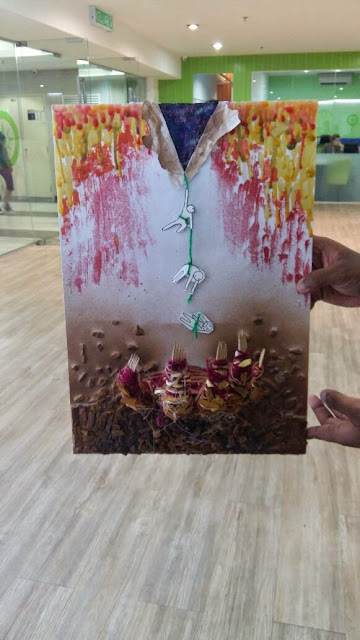Gestalt Artwork
A Robbery
A Robbery
Money = Credit Card
Tangram
TURTLE
CAMERA
ROCKET
DRAGON
KLCC
LIGHTHOUSE
THOR'S HAMMER
WHALE
Pointilism
A point is the most basic element of an artwork. Even with it's simplicity it can be used to perceive depth, movement, brightness and form. For example a darker object can be represented using only dots by making the dots closer to each other and lighter objects can be represented by dots that are further away.
A point is the most basic element of an artwork. Even with it's simplicity it can be used to perceive depth, movement, brightness and form. For example a darker object can be represented using only dots by making the dots closer to each other and lighter objects can be represented by dots that are further away.
Sketch
Final Product
Line
A line is formed by connecting two dots together. Lines are not only confined to horizontal and vertical, it can also be freeform. Due to it's flexibility, lines can be used to represent depth, brightness, shape and movement.
Artwork using random arrangement of lines
Shape
Every object has its shape or form. Shape can either be an arrangement of lines or an arrangement of points or even a combination of both. Shape can be divided in two categories, organic shapes and man-made shapes. These two types of shapes can be easily differentiated from each other because organic shapes have more unique and free-flowing form. While man-made shapes are more structured.
Organic Shapes
Man-made Shapes
Combination of the above
Texture
Texture is how the object "feels". Without even looking at the object, you can immediate distinguish it through its touch. The opposite can happen too, you can distinguish the texture through sight alone. Textures bring another level of depth to an artwork and makes it "pop".
Examples of texture
Stamping
Rubbing
Folding paper
Texture Group Artwork
For the artwork, candle wax is used to represent the stalagmites in a cave
The hand is made using wire and card as a base, then different coloured yarn is wrapped around it and toothpicks are used as fingernails
The hand is attached to the paper and wood chips are used to cover the hand to blend in with the background
Papermen are attached to a string to make it seem like they are escaping
Final Product
Value
Value can also mean the intensity of colour (how much colour there is). Monochromatic and achromatic colours are examples of value. With value alone, we can define depth, texture, brightness and shape.
Painting using only achromatic colours



























No comments:
Post a Comment